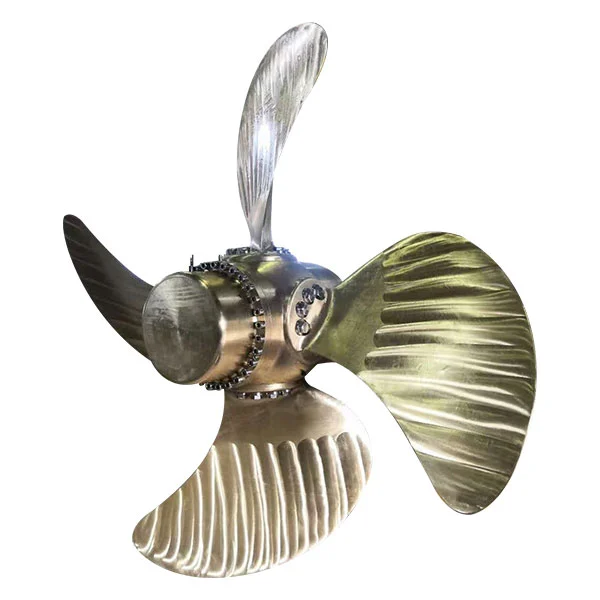Understanding Marine Propeller Maintenance: Tips for Prolonging Lifespan and Performance
2025-06-07
A marine propeller is a critical part of any boat, driving it forward and allowing it to perform effectively on the water. However, like all mechanical parts, it requires maintenance to ensure that it continues to work at its best. Neglecting propeller care can lead to performance issues, expensive repairs, and even dangerous accidents on the water. In this blog, we’ll explore essential tips for maintaining your marine propeller, how to identify signs of damage, and how to extend its lifespan.
1. Why Propeller Maintenance Matters
Marine propellers are exposed to a harsh environment—saltwater, debris, rocks, and constant motion all take a toll on the propeller’s condition. Over time, this wear and tear can cause the propeller to lose its effectiveness, leading to a decrease in speed, fuel efficiency, and maneuverability.
Preventing Performance Issues: A damaged or worn-out propeller can cause vibration, reduced thrust, and difficulty in maneuvering. Regular maintenance ensures the propeller works at peak efficiency, maintaining the boat's performance.
Protecting Your Engine: A damaged propeller can lead to imbalances that strain the engine, increasing the risk of costly engine damage. Keeping your propeller in good condition helps protect other critical parts of the boat.

2. Regular Inspections: Catch Issues Early
Performing regular inspections of your marine propeller is key to catching problems early before they escalate into costly repairs. Here’s what to look for during your inspection:
Visual Damage: Check for any visible signs of damage, such as cracks, chips, or dents. Even small imperfections can affect the efficiency of the propeller, leading to poor performance.
Corrosion: Saltwater can cause corrosion, especially if the propeller is made of materials like aluminum or bronze. Look for discoloration or pitting on the propeller’s surface, which can weaken the metal and reduce its lifespan.
Bent Blades: Bent blades can occur due to collisions with underwater objects like rocks or debris. Even minor bends can lead to imbalances and vibrations, reducing your boat’s efficiency and comfort.
Rust and Barnacles: Barnacles, algae, and other marine growth can attach to the blades, causing drag. Regularly inspect for any growth on the propeller’s surface, particularly after extended use.
3. Cleaning and Maintenance Tips
Regular cleaning of your marine propeller is essential for maintaining its efficiency and longevity. Here are a few cleaning and maintenance tips to follow:
Freshwater Rinse: After each use, rinse your propeller with freshwater to remove salt, dirt, and debris. This simple step can help prevent corrosion and buildup.
Scrubbing: Use a soft-bristled brush to scrub the blades, removing any barnacles or algae. For tougher growth, you can use a propeller cleaning tool or a non-abrasive cleaner designed for marine use.
Polishing: If your propeller is made of stainless steel or bronze, consider polishing it regularly to maintain its shine and reduce the likelihood of corrosion. A specialized propeller polish can help maintain the metal’s integrity.
4. Balancing the Propeller
Even if your propeller doesn’t show visible damage, it can become unbalanced over time, especially if it has been subject to significant wear or impact. An unbalanced propeller can cause engine strain, vibrations, and decreased performance.
Signs of Imbalance: If you notice unusual vibrations or hear a humming noise when the boat is running, it could be a sign that the propelleris out of balance.
How to Fix It: Many propeller repair shops offer balancing services. Balancing the propeller involves removing small amounts of material from the blades to ensure they are evenly weighted, which prevents vibrations and prolongs the propeller’s lifespan.
5. Repairing vs. Replacing: Knowing When It’s Time for a New Propeller
While proper care can extend the life of your propeller, there will come a time when repairs or replacements are necessary. Here’s how to know when it’s time to consider a new propeller:
Severe Damage: If the blades are severely bent or cracked, or if the propeller is pitted or corroded beyond repair, it’s time for a replacement. A damaged propeller can cause inefficiencies, and continuing to use it can lead to further damage to the engine.
Loss of Performance: If your boat’s speed and fuel efficiency have dropped significantly, even after cleaning and balancing, your propeller may be worn out and in need of replacement.
Frequent Repairs: If you find yourself constantly repairing your propeller due to minor damages, it may be more cost-effective to replace it entirely, especially if it’s nearing the end of its lifespan.
6. Storing Your Propeller During the Offseason
Proper storage is essential to prevent damage from weather conditions, corrosion, or other environmental factors. When the boating season is over, follow these storage tips:
Remove and Clean: Take the propeller off the boat and clean it thoroughly to remove any salt, dirt, or debris.
Dry Storage: Store the propeller in a dry, cool place away from humidity to prevent rust or corrosion from forming.
Inspect Annually: Before the next boating season begins, inspect the propeller for any signs of damage or wear. This will ensure that it’s in optimal condition when you hit the water again.
Conclusion:
Marine propeller maintenance is essential for keeping your boat running smoothly and ensuring that you get the best performance out of your vessel. Regular inspections, cleaning, balancing, and knowing when to replace a worn-out propeller will help extend the lifespan of your propeller and keep your boat in top condition. By following these maintenance tips, you’ll enjoy a safer, more efficient boating experience for years to come.


